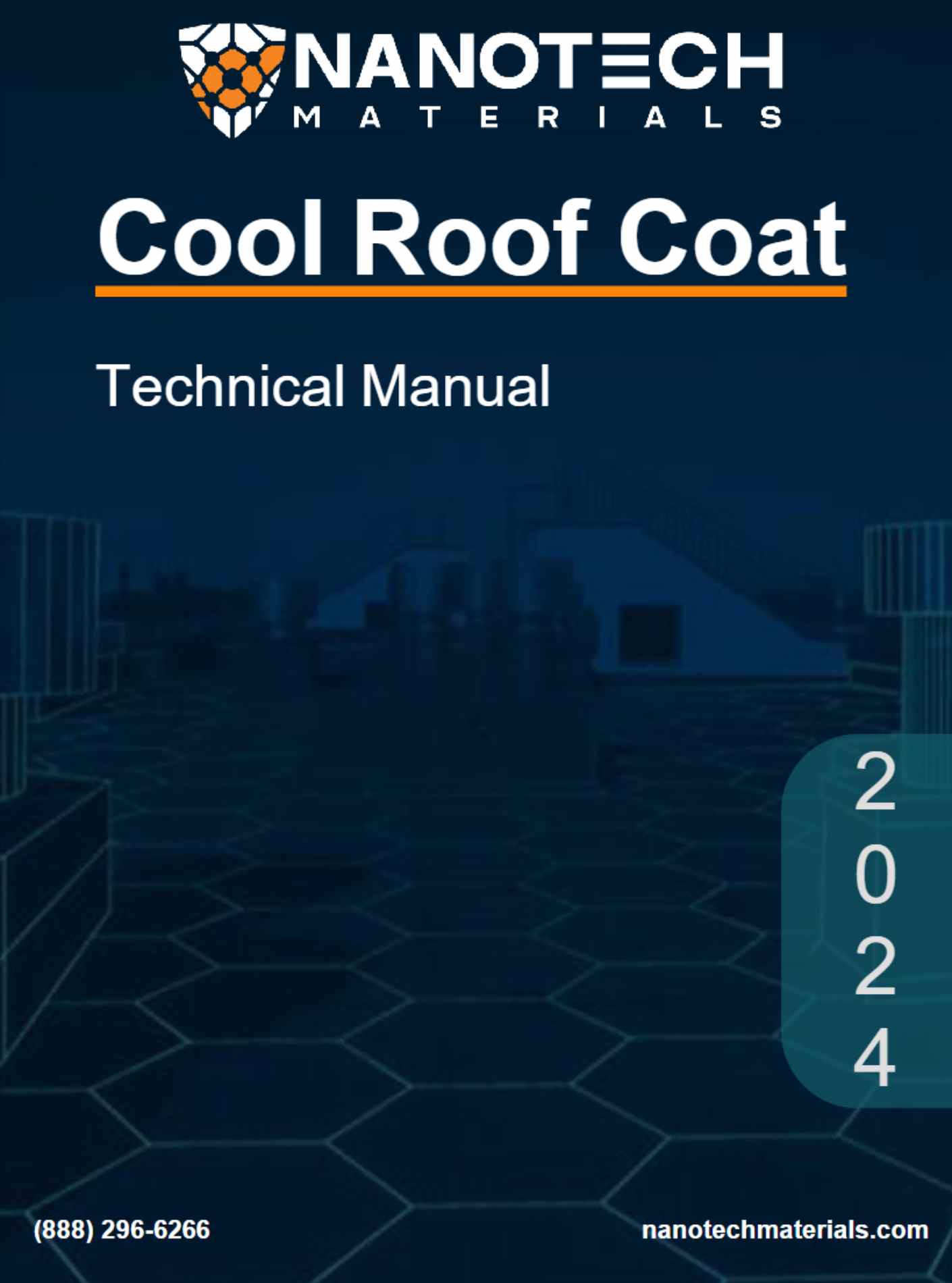COOL ROOF COAT




Energy Savings
Boost energy savings with an innovative roof coating that dramatically reduces energy use from HVAC and cooling systems. Experience significant energy savings with NanoTech’s innovative roof coating, designed to dramatically reduce HVAC costs and enhance efficiency.
Water Proofing
Add superior protection and waterproofing with a Miami-Dade County certified roof coat that safeguards against leaks from cracks and impact damage effectively.
Roof Restoration
Choose NanoTech for remediation instead of roof replacement and extend roof life while saving time and resources with a rolling 10-year warranty
Reduce CO2
Slash your carbon footprint with NanoTech by substantially cutting CO2 emissions by reducing HVAC use.
How It Works
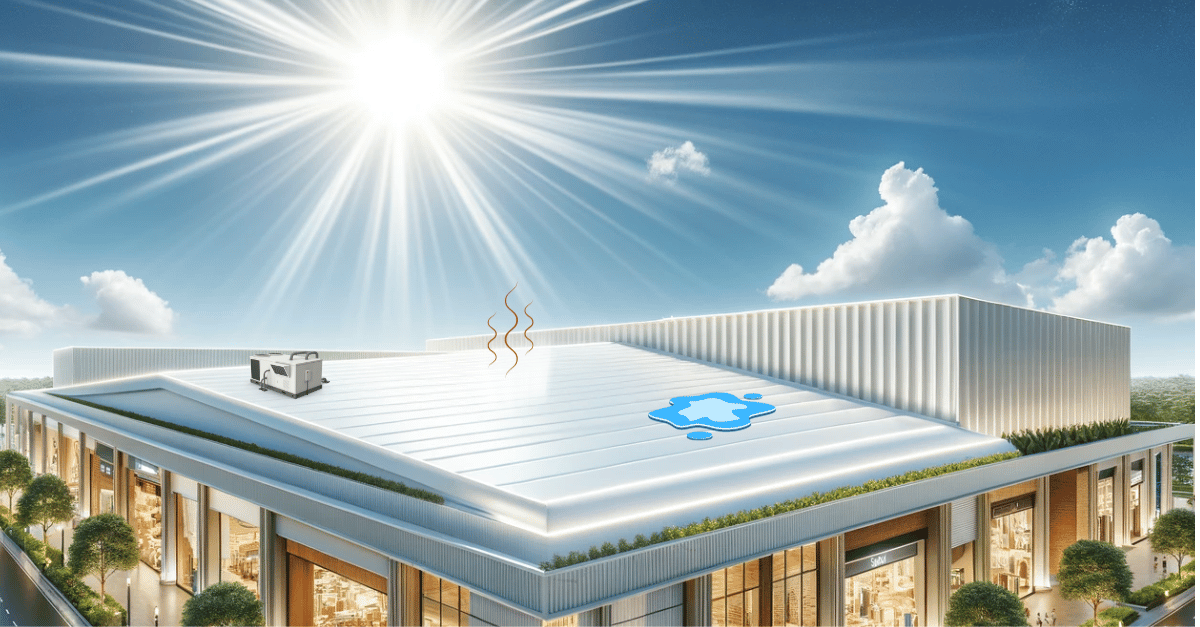
Reduce HVAC
Substantially Lower Your HVAC Use Which Reduces Energy Consumption and CO2 Emissions
High SRI
A high SRI (Solar Reflectance Index) score for roof coatings indicates superior reflectivity and thermal emittance, meaning the coating effectively reflects solar radiation and emits absorbed heat.
Waterproofing
Certified By Miami Dade and ICC to Withstand the Harshes Condition
Heat Resistance
The integration of an insulating ceramic in roof coatings that reduces thermal conductivity represents a significant advancement, offering a step change in thermal management. This innovative approach enhances the roof's insulation properties, drastically minimizing heat transfer into the building and thereby setting a new standard in roof coating performance.
Coat don't replace
A cost-effective alternative to full roof replacement that extends the life of the existing roof, backed by a 10-year rolling warranty.
Energy savings
Unprecedented heat-rejection through unusually low thermal conductivity and high emissivity with reflectivity to keep rooftop heat out, reducing operating costs even as soiling and latent heat transfer undermine conventional cool roof systems
Sustainability
40% of U.S. CO2 emissions come from building climate control; 48% of that from HVAC cooling. Lock down a step-function decrease in the energy required to cool structures, and an equally drastic reduction in carbon emissions over the long term.
Beyond SRI
NanoTech Cool Roof Coat goes far beyond basic Solar Reflectance Index (SRI) values by adding the ultra-low thermal conductivity of ICP™ technology for truly advanced thermal protection, setting a new standard in roof coating performance by minimizing heat transfer into the building.
Save Capex Coat Don't Replace
For the roof restoration market, NanoTech Cool Roof Coat offers an alternative to traditional, full tear-off jobs with heat rejection properties that exceed those of any other protective roof coating on the market. As a high-performance, elastic polymeric protective coating, certified for use in Miami-Dade County, NanoTech Cool Roof Coat stands up to the most grueling weather conditions, making it a long-lasting alternative to rip-and-replace roof restoration that adds tremendous energy efficiency.
Energy Savings Reduce HVAC Costs
High SRI (Solar Reflectance Index) for roof coatings brings superior reflectivity and thermal emittance, but NanoTech Cool Roof Coat goes beyond its 104 SRI with groundbreaking heat-rejection from the NanoTech Insulative Ceramic Particle (ICP)™ to deliver unprecedented cool-roof action. With ICP™, this roof coating effectively reflects solar radiation and prevents heat absorption to lower indoor temperatures and decreased HVAC energy consumption for cooling.
On Well Insulated Roofs
On Poorly Insulated Roofs
Conductivity
SRI-dependent products don’t mention conductivity because they conduct a lot of heat. Thanks to ICP™ technology, the ultra-low conductivity of NanoTech Cool Roof Coat has no equal in the cool roof market, across all wavelengths and sources.
Reflectivity
Shortwave radiation, including visible and near-infrared light from the sun, bounces off of reflective surfaces back into the atmosphere before converting to heat. It’s a step in the right direction, but its effectiveness is quickly compromised by dirt and soiling.
Emissivity
Longwave infrared radiation is the heat energy emitted by surfaces. Materials with higher emissivity more effectively send the heat they’ve absorbed back into the environment, and in turn cool the surface.
Cool Roof Coat SRI+
While SRI is a valuable metric for evaluating the solar reflectance and thermal emittance of roofing materials, it is flawed as a sole indicator of roof performance due to its limited scope and vulnerability to degradation. Low thermal conductivity, on the other hand, offers consistent and reliable insulation against heat transfer, enhancing energy efficiency and indoor comfort. The combination of high SRI and low thermal conductivity provides a comprehensive approach to roof design, especially in climates where managing solar heat gain is crucial.
Reflectance and Emissivity Are Not Enough
SRI primarily measures solar reflectance and thermal emittance, but does not account for how efficiently heat transfers through the material itself. Thermal conductivity measures how much heat moves past the surface, and the fact that all but one roof coat manufacturer measures and publishes this data tells a story on its own.
Performance Degradation Over Time
SRI is typically measured in a test environment under ideal, just-applied conditions. Roofs, however, are constantly exposed to elements like dust, debris, and biological growth, all of which rapidly reduce reflectance once installed, creating a significant disparity between rated and actual performance.
Limited Focus on Surface Properties
While SRI effectively gauges how a roof reflects solar radiation and emits heat, it neglects other crucial aspects like thermal conductivity, which governs heat transfer into the building.
Diminishing Returns
As SRI values rise above 100, the incremental benefits in terms of heat rejection eventually become negligible. While the highest SRI score may potentially lower surface temperatures (and cooling costs) slightly, competing on SRI alone has become a game of diminishing returns.
Year-Round Thermal Insulation
Low thermal conductivity is a key factor in maintaining energy efficiency by significantly reducing the amount of heat transferred into the building, a consistent need in hot climates.
Unaffected by External Surface Conditions
Unlike SRI-dependent products, thermal conductivity continues to work below the surface even as dirt accumulation and soiling compromise conventional heat rejection mechanisms on the surface.
Complementary to High SRI
As high SRI reduces solar heat gain in hot climates, low thermal conductivity minimizes heat ingress to provide energy efficiency on as well as below the surface.
Stability in Indoor Environments
Roof surfaces with low thermal conductivity maintain more stable indoor temperatures, reducing the load on air conditioning systems, improving occupant comfort, and protecting stored goods.
Integral to Energy Efficient Building Design
Incorporating low thermal conductivity into energy modeling for hot climates is crucial for achieving optimal energy performance, because SRI alone is no longer enough.
SRI+ Explained
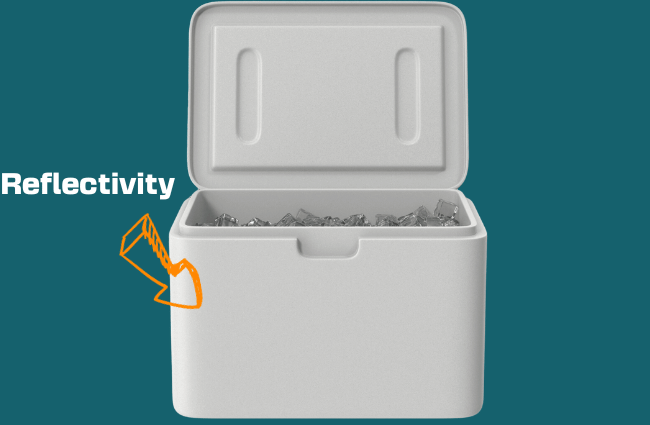
Reflectivity
Imagine the outer surface of the cooler is coated with a highly reflective material, similar to a high SRI roof coating. This reflective surface is like the cooler’s ability to reflect sunlight away, preventing the ice inside from melting quickly due to solar radiation. Just as a reflective roof reduces heat absorption, the cooler’s reflective surface keeps its contents cooler under the sun.
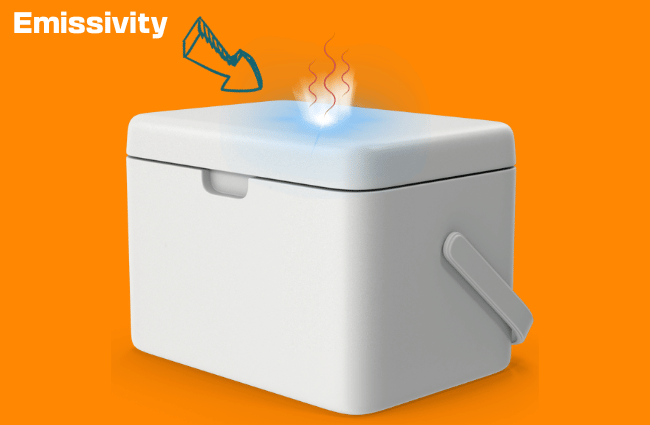
Emissivity
The cooler’s material is designed to emit any absorbed heat, much like a roof with high thermal emittance. Even if the cooler absorbs some heat from the surrounding environment, its ability to emit this heat helps in maintaining a lower internal temperature, just as a high-emissivity roof coating releases absorbed heat to keep the building cooler.
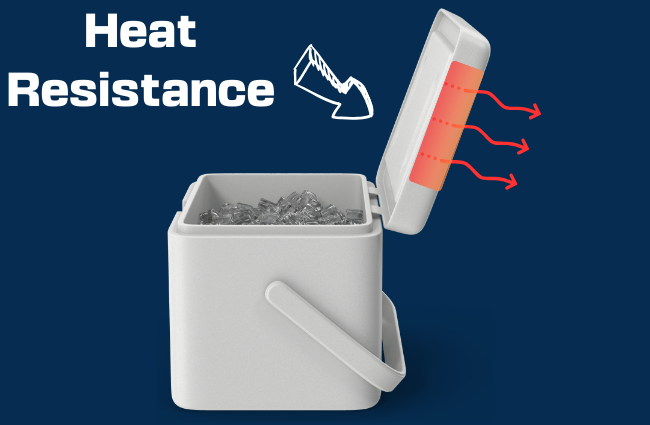
Heat Resistance
The insulation of the cooler, which prevents the transfer of heat from the outside environment to the ice inside, represents low thermal conductivity. This insulation is crucial for keeping the contents cold, similar to how low thermal conductivity in a roof coating minimizes heat transfer into a building, maintaining cooler indoor temperatures.
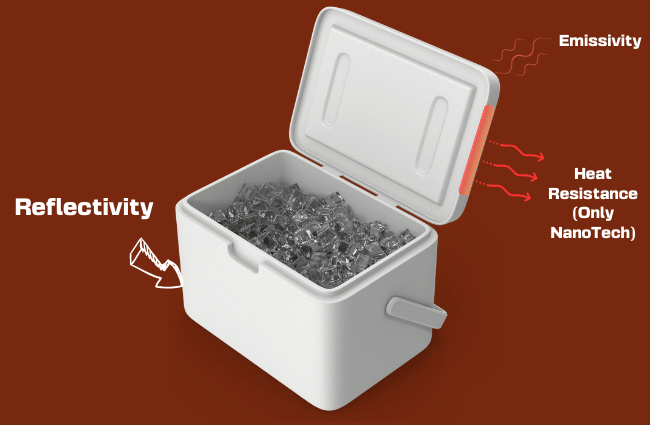
SRI +
Reflectivity and emissivity in cool roof coatings effectively reduce heat absorption and emission, but adding low thermal conductivity brings a transformative third dimension. While reflectivity minimizes solar heat gain by bouncing back sunlight, and emissivity helps in releasing absorbed heat, they primarily address the solar radiation aspect. The integration of low thermal conductivity adds critical insulation and heat resistance. This means not only is less heat absorbed from the sun, but any heat that does reach the roof is significantly impeded from entering the building. This combination offers a more comprehensive approach to thermal management, significantly enhancing overall energy efficiency and indoor comfort, and represents a substantial leap forward in cool roof technology.
Cool Roof and Coating Properties
Competition in roof coatings is stale and two-dimensional, limited to improvements in whiteness that only produce diminishing returns. Reflectivity is not only a scientific dead end because dirt quickly undermines the meager heat mitigation it provides. In the real world, the sun delivers light and heat on, across, and through surface coatings, and moisture, hail, and wind are constantly at work to undermine longevity. It’s time to fight heat in three dimensions with a tough cool roof coating that also works below the surface.
NanoTechProperties
Insulative Ceramic Particle
As a combination of high-performance, elastic, polymeric base material, NanoTech Cool Roof Coat features a groundbreaking heat-rejecting ceramic that delivers an unprecedented level of cool-roof action without the durability and longevity issues of rips from shifting or cracks from drying of conventional cool roof products.
SRI+™
NanoTech Cool Roof Coat redefines building heat-rejection efficiency by combining unusually low conductivity and high emissivity with reflectivity to keep rooftop heat out, even as soiling and latent heat transfer undermine conventional cool roof systems.
Internal Heat Reduction
NanoTech Cool Roof Coat delivers an 88% reduction in roof heat transfer – while competitors rarely achieve more than 51% – and continues to reject heat even as dirt and debris accumulate over time.
Emissions Reduction
A roof surface treated with NanoTech Cool Roof Coat lowers indoor temperatures by 25-45°F, reducing the carbon emissions of a 25,000 sq ft building by 76 tons annually.
NanoTechProperties
Remediate vs. Replace
Certified
NanoTech Cool Roof Coat delivers unprecedented heat rejection in a non-toxic, non-VOC protective coating system that holds Miami-Dade County, ISO 9001, and International Building Code® (IBC®) certifications to meet the highest standards of safety, durability, and code and standards compliance.
Warranty
NanoTech’s Cool Roof Coat offers a unique rolling 10-year warranty, allowing for a simple top coat application after a decade to extend the protection. This approach significantly defers the need and expense of full roof replacement, providing a cost-effective, long-term roofing solution.
Case Study
NanoTech Cool Roof Coat is Available On: Roof Substrates
Reduced HVAC Draw By 49%
NanoTech’s Cool Roof Coat, featuring an insulative ceramic particle with low thermal conductivity, was applied to a 180,000 sq ft metal roof retail center, resulting in a notable internal temperature drop from 111°F to 77°F. This 34°F decrease inside the building, leading to a 49% reduction in HVAC usage over the summer, demonstrates the coating’s effectiveness not just in surface heat reflection but crucially in preventing heat penetration into the building, where it matters most.
The temperature readings were taken on the inside ceiling of a large retail center. The before temp as taken in Celicius at 44.6 C or 111°F. After the coating the internal temperature dropped to 77°F representing a 34°F drop on the INSIDE of the building.
NanoTech Cool Roof Testing Results
The NanoTech Cool Roof Coat was subjected to extensive testing under ASTM D6083 standards, demonstrating its high quality and reliability. It successfully met rigorous criteria for durability, weather resistance, and overall performance, proving its effectiveness as a roof coating material. This comprehensive assessment confirms its suitability for providing robust and long-lasting roof protection.
*Tested by accredited 3rd party lab for Miami Dade. Tests are passed and pending filing with the county.
Videos And Documentation
Videos and Documentation
Training Videos
Product Circulation and Prep
Proper Inspection & Cleaning For a Metal R-Panel Roofing System
Applying NanoTech Cool Roof Coat to an EPDM Roofing System
Applying NanoTech Cool Roof Coat to an Exposed Fastener Metal Panel Roofing System
Applying NanoTech Cool Roof Coat to a Modified Bitumen Roofing System
Applying NanoTech Cool Roof Coat to a TPO Roofing System
Documentation
FAQ
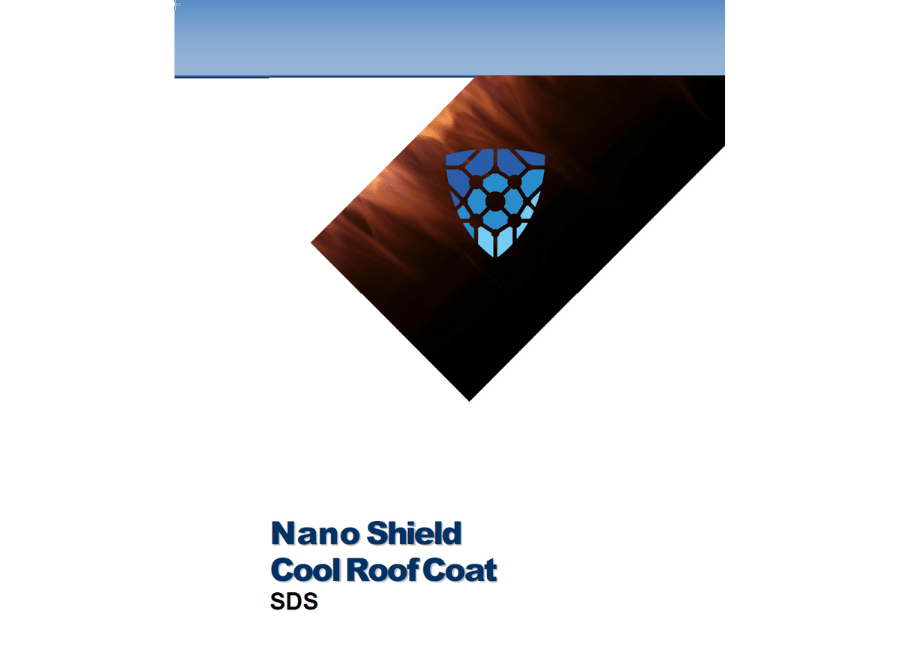
NanoTech Cool Roof Coat SDS
This is the SDS for the Nano Shield Roof Coat product
Other Case Studies
NanoTech Cool Roof Coat is a versatile solution which has been deployed and proven effective on buildings across a variety of sectors, including large retail centers, industrial warehouses, residential complexes, as well as educational institutions. Each project stands as a testament to the coating’s adaptability, utility, and effectiveness in a variety of settings.
Remediation Vs. Tear-Off
In Texas, the owners of a three-story building facing a costly roof replacement found a smarter solution in NanoTech Cool Roof Coating. In opting for coating over a full tear-off, the building owner not only saved approximately 75% on expenses but also secured the roof’s future with NanoTech’s 10-year rolling warranty. This decision not only provided a cost-effective alternative to roof replacement but also brought additional benefits in energy savings, serving as the proverbial ‘gravy on top.’ The project stands as a prime example of how innovative roofing solutions can offer both economic and environmental advantages.
Residential (Non-Shingle Roofs)
NanoTech Cool Roof Coating has demonstrated its remarkable efficacy on a leaky residential TPO roof. Not only was the life of the roof extended by an impressive 10 years, but the homeowner also enjoyed a 30% reduction in utility bills during the summer months. The dual benefits of enhanced durability and substantial energy savings exemplify the transformative impact of NanoTech ICP technology in residential settings, offering a practical, cost-effective solution for common roofing challenges.
Employee Comfort
After applying NanoTech Cool Roof Coat to a metal roof at a Domino’s Pizza outlet, a significant improvement in indoor temperature control was observed. What had previously been a struggle to keep the interior below 80°F, the establishment now enjoys a comfortable 73°F post-coating. This enhancement not only made for a more pleasant customer experience but also had a positive impact on worker retention, demonstrating the tangible benefits of NanoTech’s innovative roofing solution in a commercial setting.
Warehouse
The application of NanoTech Cool Roof Coat to an open-air warehouse yielded dramatic results in temperature reduction. Prior to the coating, the internal roof temperature soared to 162°F, with the inside warehouse temperature reaching 125°F. Post-application, the internal roof temperature plummeted by an astonishing 57°F, matching warehouse temperature with the ambient external temperature, creating a more comfortable and safer environment for workers in this industrial setting.

